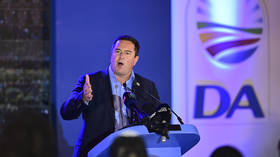Hornless ‘Frankencow’: Genetic engineers aim to create super-bovine

UK and US scientists are seeking to alter the genes of dairy cows in order to make them hornless. The modification is meant to make the livestock safer to deal with, and spare them the painful de-horning practice currently used by farmers.
Scientists have managed to single out DNA that suppresses horn
growth in other breeds of cattle, which they now intend to implant
into the genome of the Holstein cows – the world's
highest-production dairy breed.
“This would be a major advance in animal welfare,”
Geoff Simm, a scholar and chair of the UK government’s Farm Animal
Genetic Resources Committee said, according to the Sunday Times.
The idea – the brainchild of scientists at Edinburgh's Roslin
Institute – will now be brought to life by their partners from the
University of Minnesota, who were already conducting similar
research.
Scott Fahrenkrug, a professor of genetics at the University of
Minnesota, has extracted a short strip of DNA from the genome of
Red Angus cattle. The strip, which is known to halt horn growth,
was then inserted into the cells from a Holstein bull called
Randy.
“We have already made millions of modified cells. Next we will
use cloning technology to turn some of those cells into 40 embryos
and implant them into a herd of surrogate mothers, in the Midwest
of America, within weeks,” Fahrenkrug told the Sunday
Times.
The derivative cattle will all be clones of Randy without the
horns, and their offspring should be hornless as well. Scientists
had previously managed to rid beef cattle of their horns through
breeding. The same technique has not worked for dairy cows,
however, as it apparently stunted their lactation.

Farmers have traditionally resorted to burning off calf’s horns buds, a painful procedure which animal rights advocates have condemned as cruel. Genetically dehorning cattle is the most recent in a series of attempts to apply genetic-modification techniques to dairy cows.
In October 2012, scientists in New Zealand announced they had created genetically modified cow whose milk is allergy-free.
In June 2012, Chinese scientists touted a GM breakthrough: Altering bovine genes in order to make milk low-lactose. In 2011, they introduced human DNA into the cow’s genome to make cow milk similar to human breast milk.
Despite the perceived benefits GM technology has offered, it has often come up against stiff resistance from critics calling its agricultural application 'Frankenstein farming.'
Genetically modified cows are created with the help of cloning, a highly contentious practice due to the high death rate among cloned animals, which often suffer health problems.
Recent research conducted by French scientists also revealed that rats fed on GMO corn sold by the US firm Monsanto suffered tumors and other internal organ damage, fueling suspicions that the full health implications of genetic modification are not yet entirely understood.
“This study finally shows we are right and that it is urgent to quickly review all GMO evaluation processes ,” said Jose Bove, vice chair of the European Parliament’s commission for agriculture.













